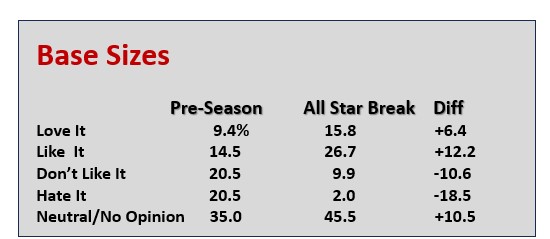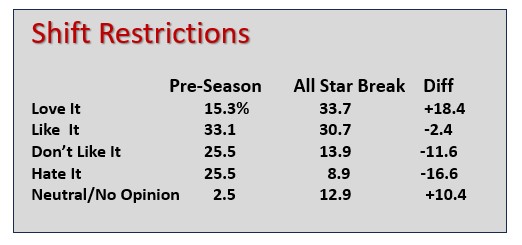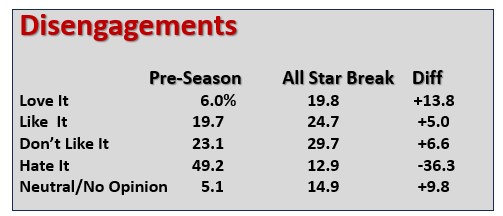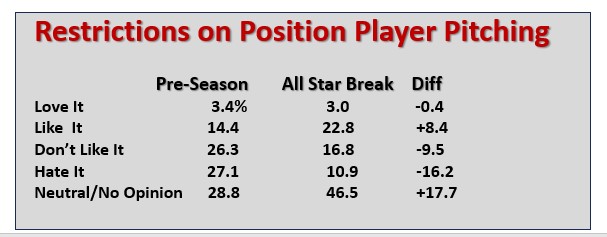Back in March, when MLB announced a number of rules changes for 2023 (along with making the placed runner at second base in extra innings permanent), Baseball Roundtable asked readers for their opinions on MLB’s actions (118 readers responded). At the All Star Break, with fans having just over a half season to judge the new rules, The Roundtable repeated the survey (101 readers responded).
The All Star Break survey also included an open-ended question, asking readers what they felt were the most pressing issues facing MLB today. (Forty-nine of the respondents answered that question and – spoiler alert, this post will cover those responses in detail later) – the cost of attending a game and the predominance of the “three true outcomes” (strikeouts, home runs and walks) led the way.
As noted, we’ll take a look at those open-ended responses later. Let’s get back to the new rules. The reader survey results indicate that, in practice, the new rules have gained fans among the fans.
For example, while just over half of the pre-season survey respondents (51%) said they Did Not Like or Hated the restriction on infield shifts – at the All-Star Break, that figure was down to 23.5%. Similarly, in the pre-season survey, 56.8% said they Liked or Loved the idea of a pitch clock. After seeing it in action, at the All-Star Break that group was up to 75%. The (now permanent) extra-inning placed runner at second base did not fare as well, with those who Don’t Like or Hate the rule dropping just slightly – from 78% percent to 72%. But, I’m getting ahead of myself. Let’s look at the questions and responses. Note: Due to rounding percentages do not always total 100%.
INFIELD SHIFT RESTRICTIONS
Two infielders must be on each side of second base and within the boundaries of the infield as a pitch is thrown. Also, infielders may not switch sides during a given inning (you can’t move your best infielder to the opposite side of the second base bag for a specific hitter). Side note: A team may still choose to bring an outfielder into the infield as a fifth infielder. Penalty: A Ball is called.
Big gains were seen in the support for the restrictions on infield shifts. While the pre-season split was fairly even (51% in the Dislike It/Hate It groups and 48.4% in Like It/Love It), at the All Star Break, the Like It/Love It cadre was up to 64.4%, while the Don’t Like It/Hate It groups were down to 22.8%
Baseball Roundtable Take: Originally, I was in favor a modified version of this rule – putting the new restrictions in place, but allowing managers to use an exaggerated shift a limited number of times (two or three) per game. (Making using the shift a strategic decision.) I do like the way that new rule has affected game play, so put me in the convert group.
PITCH CLOCK
This change put in place a 30-second time limit between each batter, 15-second pitch clock with bases empty (pitcher must deliver the ball within 15-seconds of receiving it), 20 seconds with runner(s) on base. Also, batters must be in the batter’s box and ready by the time there are eight-seconds left on pitch clock. Note: With runners on base, the timer resets if the pitcher steps off the rubber or attempts a pickoff (these are “disengagements), with a limit of two disengagements per plate appearance (more on that later). The timer is also reset if a baserunner advances during a plate appearance. In addition, batters are allowed one time out during a plate appearance. Penalties: Pitcher violation – called Ball; Batter violation – called Strike.
Wow, the percentage of respondents saying they Hated the idea of a pitch clock dropped from 18.6% in the pre-season survey to 7.0% in the All Star Break survey. At the same time, the Love It group jumped from 27.1% to 46%. Overall, this one looks like a winner, with the Love It/Like It cadres at the All Star Break standing as 75%.
Baseball Roundtable Take: Clearly, fans appreciate the quicker pace of the game under the new rules. It does create a challenge for those of us who maintain a scorecard. (I took a stopwatch to a couple of games and found that if you took a seven-minute break – starting with the final out of a half inning – to go to the concession stands or restroom – you could count on missing 3-4 batters before you got back to your seat. Still, it seems to be working (even better than I expected), the fans like it and the players adjusted quickly, so I’m on board. What I would like to see is a return of vendors to the stands (my hometown Twins do not have vendors in aisles), to reduce the potential for missing plays.
DISENGAGEMENT RULE
Pitchers are allowed just two “disengagements” (pick-off attempts, fake pick-offs, stepping off the rubber, defensive time out) per plate appearance – with the disengagement count reset if a runner advances a base within the plate appearance. No penalty on a third pick-off attempt if it produces an out. Penalty: If a pitcher steps off or attempts a pick-off a third time, it is treated as a Balk (runners advance) – unless the pick-off is successful (an out is recorded), then there is no penalty.
Lots of opposition (pre-season) here, with the Don’t Like/Hate It groups at 72.3%. That opposition was down to 42.6%t at the All Star Break. Still, lots of room for debate on this one. At the All Star Break, the Like It/Love It and Don’t Like It/Hate it groups were fairly evenly split, 44.5% and 42.6%, respectively.
Baseball Roundtable Take: I’m not a big fan of limiting pick-off attempts. I like the pitcher-base runner “cat and mouse” game – and consider pick-off plays to be on-field “action.” I do appreciate the third pick-off not being a violation if an out is recorded (which prevents runners from taking extraordinary leads after the allowed two disengagements). I, personally, would like to see MLB disengage itself from this rule.
RUNNER PLACED AT SECOND BASE IN EXTRA INNINGS
Still unpopular – but now “permanent.” In the pre-season survey 75% of respondents said they Disliked or Hated this rule. At All Star Break, that figure was down only slightly – to 70.2%. Not a lot of movement and still plenty of disgruntled fans.
Baseball Roundtable Take: Totally agree with the bulk of survey respondents. To me, this rule change is a step too far. My stance is that “earned” runners, not “gift” runners, should decide a ball game. Yes, it does seem to be shortening extra-inning contests (I’m not convinced that’s a good thing). However, it also changes the basic structure and strategy of the game, not to mention skewing statistics. Heck, a relief pitcher can get tagged with a loss without allowing a baserunner (bunt and sacrifice fly) and a batter can make an out to end an inning and be credited with a run scored in the next inning – without making a plate appearance.
RESTRICTIONS ON POSITION PLAYER PITCHING APPEARANCES
Last season, position players could only be brought in to pitch in extra innings or if the player’s team was trailing by at least six runs. In 2023, position player can be brought in to pitch in extra innings or if the player’s team is trailing by at least eight runs (at any time) or ahead by at least ten runs in the ninth inning.
The Don’t Like It /Hate it group was down from 53.4% pre-season to 27.7% at the All-Star break. Notably, the biggest part of that jump came in a move to the Neutral/No Opinion group (up from 28.8% to 46.5%).
Baseball Roundtable Take: Very close to a distinction without a difference.
WAVE ‘EM-TO-FIRST INTENTIONAL WALK
Okay, I threw this one in there (get the pun) just because I don’t like this rule. The last time I surveyed readers on this one was in 2022 and the split was 48.0% Like and 41.2% Dislike. It hasn’t changed much, it’s now 46.5% Like to 40.6% Dislike.
Baseball Roundtable Take: I still don’t like it, but it’s not a big deal.
INCREASED BASE SIZES
MLB bases are up to 18 x 18 inches – from 15 x 15 inches. I was actually surprised by the number of responders to the pre-season survey who voiced opinions on this one (only 35% answered Neutral/No Opinion). Apparently, once in action, fewer fans noticed a difference – as the Neutral/No Opinion percentage was up to 45.5% at the All Star Break. The gain in “neutrality” came among those who initially were opposed to the change.
Baseball Roundtable Take: If you consider this a safety issue, giving fielders and runners more space to operate in, I’m on board. If the argument is that it increases action on the base paths, my answer is “Yawn.” Baseball may be a game of inches, but I don’t think these few inches make much of a difference. (For the running game, the disengagement rule will have much more of an impact.)
ELECTRONIC BALL/STRIKE CALLS
MLB has been talking about an electric strike zone and a few options seems to be on the table. Here are how those options fared with the fans.
35.6% … Have umpires continue to make the call, but allow a specific number of ball/strike challenges per game. The umpire would the refer to the electronic system to resolve the challenge. (Successful challenges would not count against the limit.)
29.7% … Leave things the way they are. Let the umps make the call.
28.7% … Have all ball/strike calls made electronically and relayed to the home plate umpire.
5.9% … Neutral/No Opinion.
Baseball Roundtable Take: Not a fan of this potential change. I do like to watch those pitchers with the skills to “expand” the strike zone. Still, if it comes to this, I can live with it. I do miss the days, however, when the philosophy was that – whether at the plate or on the basses – the umpires’ “calls” would even out. I just hate to see MLB take more and more of the human factor out of the game. Plus, if we ever get to an all-electronic umpiring system, where will all the in-game “great debates” come from?
—-MLB’S MOST PRESSING ISSUES – OPEN-ENDED QUESTION—-
Forty-nine respondents answer the open-ended question “What do you, as a fan, see as the most important issue(s) facing major league baseball today?”
The clear leaders, in terms of times mentioned, were the cost of going to a game and a desire to see for more balls in play (too many strikeouts/too many “True Outcomes” … K/BB/HR).
Here are the issues that came up on more than one survey.
Cost of Going to a Game … 14 Responses
Too Many Strikeouts/Too Many ”True Outcomes” (K/BB/HR) …. 12 Responses
Too Many Rules Changes … Seven Responses
Local TV Blackouts … Seven Responses
Competitive Imbalance Among Teams … Five Responses
Balancing “Tradition” with the Need to Respond to Today’s Reduced Attentions Spans/Tech Options … Four Responses
Inaccurate Ball/Strike Calls … Three Responses
Revenue Disparity Among Teams … Three Responses
Player Salaries … Two Responses
Too Many Pitching Changes … Two Responses
Need to Expand/Realign — Two Responses
Here a few answers that Baseball Roundtable found particularly interesting:
“Economics. Small-market teams can’t compete because local-market TV income is exponentially smaller than a well-managed large market rights package. Make all media income distributed between the teams and institute a minimum total player salary structure to go along with the soft salary cap (with graduated penalties when exceeded). The teams have to cooperate in getting a viable product on the field, or else only the rich market teams can survive.
_________________________
“Relocation and expansion. The question of too many teams making the playoffs that it makes the regular season mute to some degree”
__________________________________
“MLB getting into bed with big gambling is a Faustian Bargain and an existential threat. It is not a matter of IF but WHEN there will be a major scandal that will harm MLB’s version of the game. MLB needs to drop all ties with gambling companies, fantasy sports, etc. They told us for a hundred years that gambling and baseball don’t mix and now it’s all good in the hood, because they are making tons of $$$ from gambling. Not only that, MLB has made and its customers potential marks for the gambling operators.”
——————————-
I think the most important issues are around diversity and inclusion. Too few Black managers – a legacy of systemic racism. Not enough acceptance of LGBTQ+ players, coaches, and staff (no major league players has come out), even with Pride Nights at all levels. I would also like to see women playing, not just coaching, and managing at the major league level.
So, there you have it. Thanks to all those who responded, as well as to those who are reading the results.
Baseball Roundtable – Blogging Baseball Since 2012.

 Baseball Roundtable is on the Feedspot list of the Top 100 Baseball Blogs. To see the full list, click here.
Baseball Roundtable is on the Feedspot list of the Top 100 Baseball Blogs. To see the full list, click here.
Baseball Roundtable is also on the Anytime Baseball Supply Top 66 Baseball Sites list. For the full list, click here.
I tweet (on X) baseball @DavidBaseballRT
Follow/Like Baseball Roundtable’s Facebook Page here. Find More baseball commentary; blog post notifications; PRIZES.
Member: Society for American Baseball Research (SABR); Negro Leagues Baseball Museum; The Baseball Reliquary.











